In the so-called Alto Valle of Río Negro, at the source of the heaviest flowing river in the Patagonia, a centuries old production tradition combines with exceptional natural conditions to create top range wines. Mainqué, Valle Azul, Chinchinales, Villa Regina, Ingeniero Huergo, Fernández Oro and Cervantes are the villages where grapes are processed to make great wines in southern Argentina.
Text: Mar Romero
The arrival of investments, modern technology and the knowledge of distinguished foreign professionals enabled Argentinian wine to make a significant, qualitative turnaround at the beginning of the 1990s, and take up position in world rankings. This was how the Malbec grape became popular in the US, and the name of Mendoza was heard again and again in Europe and neighbouring countries, like Brazil.
Now, Argentina is entering a new phase, adding production areas, grape varieties and wine styles. Now it would be wrong to talk about “vino mendocino” or wine from Mendoza, or to group multiple regions like Alto Valle del Río Negro, the Atlantic coast or the budding, adventurous vineyards in Chubut under the general name of “Patagonia”. You see, Patagonia is a vast area which already has four wine making provinces in full swing, and each terrain has developed completely independently.
A desert oasis
In the middle of desert lands, Río Negro traverses the largest valley in the Argentinian Patagonia. The colonisers channelled water from the Andes for irrigation, and thus created a productive oasis with deep clay loam soils.
The climate is ideal for growing vines; cold winters and dry summers, with a significant temperature range. Warm, bright days and very fresh nights allow the grapes to ripen slowly and gradually, ensuring the balance between acidity and sugar, and a good proportion of aromatic substances and excellent colouring. The intense, frequent winds, together with a low annual rainfall and little humidity are very favourable conditions for sustainable vine growing, without the need for agrochemicals.
One important differentiating factor of the vineyards lying along the valley, is the protection that the forest curtain provides from the Patagonian winds. The vineyards only stand at 250 metres above sea-level and the greatest risk they face are the late spring frosts.
Lying in the north of Patagonia, Río Negro is Argentina’s fourth most significant wine province, with a total surface area under vine of 1,674 hectares and producing about 45,000 hectolitres per year, less than one percent of the country’s total.
In the department of General Roca, in what is called the Alto Valle de Río Negro, we find the oldest vineyards that led to the province’s vine growing and wine making tradition. A little further east, along the river that runs into the Atlantic Ocean, Valle Medio appears, and the centre of this valley is Choele Choel island, where we also find old vineyards. The natural terrain offers an ideal habitat for red varieties like Merlot, Pinot Noir and Malbec, while Semillón and Sauvignon Blanc stand out among the whites. The wines from Río Negro are typical cold region wines, with well-defined aromas and interesting characteristics.
A little bit of history
In the 1920s, alongside the production of alfalfa which was started by the mainly Spanish and Italians settlers, with the arrival of fruit trees, vine growing became one of the new agricultural additions, and the farmers provided their grapes to make wines for home drinking.
At the end of the decade, they started to make their first wines, following the example of the pioneer, Humberto Canale. However, vineyard plantation stopped in 1934, when the wine regulating board passed a national law resulting from excess wine production in Alto Valle. The law levied a tax applicable to each new vineyard hectare, and this led people to plant fruit trees, and thus the boom in apples and pears in this area.
In the 1950s, a series of new wineries were opened which helped to boost the industry. During these years, the Instituto Nacional de Tecnología Agropecuaria (INTA) opened a head office to promote the area’s technical, economic and social development. In 1958, French technicians from the firm, Chandon, conducted studies on the intention to acquire 400 hectares in the area, to make sparkling wines from Chardonnay and Pinot Noir. The project did not take off due to red tape, but the Río Negro area was already earmarked as ideal for producing top range wines.
Despite the subsequent crises in the 70s, due to little or negative profitability in the vineyard, for various reasons, it is worth highlighting that there has always been quality vine growing and wine making here, albeit on a small scale and supported by a handful of wineries. They are the ones who have been aware of the area’s vine and wine vocation, and they have started to demand measures to protect their quality product; knocking on the doors of the various entities and asking them to promote the wines, penetrate markets and use technology to plant vineyards for making fine wines and sparkling wines, called champañas here. Today, we can say that Alto Valle is one of the largest wine regions in Argentina, and it has well-differentiated and identified subareas.
Historic wineries
If we want to go into the vine and wine history of Alto Valle de Río Negro, we have to visit the Humberto Canale winery, in General Roca. The family has been making wines in this area for five generations. Today, the soul of the oldest and most important winery in Patagonia is Guillermo Barzi Canale. He embodies the dream of his great-grandfather, Humberto Canale, the founder of this centenary company that is associated with the growth of Argentina and the development of the area following the arrival of the railway in 1900.
It was the country’s first winery to bottle a varietal Semillón wine, in 1976. Now it is paying tribute to its old vineyards with a new label, Humberto Canale Old Vineyard Semillón, made with grapes from a vineyard planted in 1942. The inspiration behind each variety are the different personalities of the family’s grandchildren: Pinot Noir and Riesling are associated with the women in the family and Malbec is inspired by the men. Their winery is an example of success, as they have managed to combine their historic legacy with the most sophisticated technology in their export wines.
The history of the Herzig family, from Bodega Museo La Falda (Cipolletti), also illustrates the vine and wine development in Alto Valle, which began at the end of the 19th century at the hand of European immigrants. The family’s third generation transformed this winery into a museum that opened its doors to curious tourists in 1910. The winery managed to build up 150 hectares under vine and to produce a million litres of wine a year, directly employing over 120 people. It is now an artisan winery and offers a combination of wine tasting, museum visit and meal. An example of the past and present Río Negro economy, a few steps from the centre of the city of Cipolletti.
Valle Azul
It is also essential that you visit the 1932 and 1955 vineyards belonging to the winery, Noemía, and learn about its wine making tradition. Countess Noemí Marone Cinzano was a top quality wine producer on her property Argiano in Tuscany and, together with her colleague and life-long partner, the oenologist and wine maker Hans Vinding Diers (of Danish origin and born in Stellenbosch, the birthplace of the best wines in South Africa and trained in Graves, Bordeaux, where his family owned Chateau Rahoul and Chateau de Landiras), they recognised the potential of this arid steppe land in Valle Azul, as soon as they saw it, and decided to set up their winery there. They also built their home here and looked for the orientation of their vineyards which they tend to following biodynamic methods. Hans also created the distinguished Chacra de Patagonia wines, belonging to Piero Incisa della Rochetta, considered to the world’s best Pinot Noir producer. Two of their wines are among the best in Argentina, according to the guru, Robert Parker.
At Noemía, they have shown their respect for the land and the environment, by transmitting the identity of their Malbec wines, which are unique. By combining harvests in the two hemispheres, they have become luxury ambassadors for Río Negro and Argentina.
Another well-known name is Bodega Favretto (Villa Regina), the town’s historical producer who sold wines in demi-johns. In recent years, Gustavo Favretto, grandson of the founder, has thrown himself into turning the winery around and producing top range wines. He is creating a line of varietal wines made with their own grapes, in a rich region close to Valle Azul, about 30 kilometres from Villa Regina.
To achieve their goal, they reconverted vineyards and invested in technology so that they could abandon common, table wines and make limited editions instead. Sometimes, these editions are not carried through because the winery only bottles the wine that exceeds its levels of quality. The premium wine lines have a distinctive feature: some barrels, others with chips. The idea is to play with the elements available and look for increasingly more complex aromas. Along these lines, they also produce the Oir line, (“río” backwards, i.e. Río Negro). The red wine, Ferrucio Favretto, is named after the grandfather and founder, and it is the top wine in their range; a Malbec coupage made up of three different vintages.
French inspiration
About 3 kilometres to the west of General Roca, on Ruta Nacional 22 near J.J.Gómez, we find Bodega Fabre (General Roca). After investing in Mendoza, in the Fabre & Montmayou winery, Hervé Joyaux Fabre decided to buy a winery and some vineyards in Río Negro, which he called Infinitus.
In Joyaux’s own words, “the Infinitus wines express the citric aromas of the Semillón grape, the elegance of Chardonnay, the charm of the Patagonia Malbec, the strength of the Cabernet Sauvignon and the roundness of the Merlot”.
In this harsh land, they use the same tradition and savoir faire from Bordeaux, as they applied in Mendoza. The vineyards are cultivated using sustainable methods so as to respect the terroir and obtain the maximum expression. In November, part of the harvest is sometimes sacrificed to ensure they obtain the wine’s best concentration and maturity. They age all their wines in tanks and French oak for twelve months.
Spanish presence
There are also small wine projects like Bodega del Río Elorza (Fernández Oro), a state-of-the-art boutique-type winery that makes top range wines with their own vines. It was acquired in 2001 and has forty hectares in Colonia Lucinda, where there had been a vineyard before, in the first few decades of the 20th century. In 2004 they started the task of recovering the almost centenary vines in the old vineyards, which until then had been abandoned. They planted twenty hectares with specially selected clones of Malbec, Pinot Noir, Merlot, Cabernet Franc and Chardonnay, all adapted to the Patagonia land.
To fulfil their expectations, they also added the skill of the well-known Hans Vinding-Diers, and a group of excellent professionals who share their passion for making great wines, including the agricultural engineer, Marcelo Casazza and the oenologist, Agustín Ezequiel Lombroni.
It was easy for the family from Río Elorza and the López Montero family who own the Verum winery in Tomelloso (Cuidad Real) in Spain, to reach an agreement over the Verum by Verum project. This also involved Hans Vinding-Diers for some years, although he will not be taking part in the 2020 harvest.
In 2016, the oenologist Elías López Montero found a plot, surprisingly with the same name as his mother, and he fell in love with it. Perhaps he thought it was a good omen, particularly after learning about the conditions in this glamorous region for growing vines. Today, he has already produced four vintages of María Victoria Malbec, which is different from the Malbec in Mendoza, because it has a lower alcohol content and greater acidity.
To complete their range, they are preparing a Chardonnay fermented in 500 l barrels and will launch about 1500 bottles in a few months, and a Pinot Noir made with wood and steel that will be released later. Therefore, Bodegas y Viñedos Verum has become the first Spanish winery to produce wines in southern Argentina.
Small productions
The Agrestis vineyards and winery (General Roca), belong to a traditional family in Valle, and the premises lie about three kilometres from the city of General Roca. All the grapes used to make the Agrestis wines come from their own vineyard, where they have vines imported from France. They specialise in producing natural sparkling wines, using the traditional method of fermenting in the bottle, and they also make still varietal wines.
Their varieties include Chardonnay and Pinot Noir, for the sparkling wines, and Cabernet Sauvignon, Pinot noir and Merlot for fine varietal wines. They also have a small Gewürztraminer vineyard, which is not producing yet.
At present, their annual production volume is 20,000 bottles of Vino Espumante Nature, 5000 bottles of Rosé Nature, 3000 bottles of Pinot Noir, 5000 bottles of Cabernet Sauvignon and 2000 bottles of Chardonnay.
Bodegas Gennari (General Fernández Oro), is also a historical winery in Río Negro. Although the family’s main production since 1957 has been dried fruit, they have not abandoned their wine production. The founder, Emilio Gennari, started selling demijohns of their Malbec red locally when, at the time, people were only selling rosé wine. He had inherited 17 hectares planted with this variety and managed to make himself a niche in the market. The winery is run today by the second generation, his children, Osvaldo and Ana. They have three lines of wines, Familia Gennari, Garrón de Piedra and Parada 81, from the 80-year old vineyards in the area of Barda. They produce between seventy and ninety thousand litres.
Marcelo Miras is one of the best oenologists in the Patagonia, and a fundamental part of the history of Río Negro wines. Apart from his own family project in the Miras winery (General Fernández Oro), he is also the director of vine and wine growing in the province. His job as chief oenologist in a huge Patagonian winery, such as Bodega del Fin del Mundo, alongside Michel Rolland, introduced him to most grape producers, whom he worked with for many years to include them in his personal project.
Marcelo has created his own style that has managed to rescue forgotten vines and promote varietals that few people defended until only recently in Río Negro, such as Merlot. He also defends the Malbec grape for obtaining quality wines, both young and aged, as it expresses the typical mineral nature of the Patagonia. He has also been one of the great pioneers of Cabernet Franc, a variety famous for its ability to adapt to the terroir and to produce different wine styles.
He had always bought grapes for his winery from the vineyards lying in the best areas of Alto Valle. However, the 2014 vintage was the first time he used grapes from a 20-year old vineyard in the Cervantes micro-region, belonging to his son, Pablo. The first time his own vineyards were used for a vintage, that is consolidated by its combination of appropriate fruit and wood, resulting in honest, expressive wines without any excesses. Their future lies in continuing this growth, and taking every effort to maintain the quality. The Miras wines are exported to US, Canada, Brazil, Peru, Bolivia, Chile, Belgium, Denmark, Germany and China.
Sustainable agriculture
Another family winery is Finca Aniello (Mainque), which has one of the most spectacular vineyards in the Patagonia. It was started in 2010 when the family bought an estate called 006, planted in the Mainqué district back in 1998. The diverse nature of its soils means they can harvest the same variety (Malbec and Merlot) at three different times, resulting in different, complementary wines. In the second stage they bought an old winery in the area, which was built in 1927 and had one hectare under vine, planted in 1932, and four other hectares planted in 1947. They use a mass selection of pre-phylloxera Malbec, which is currently being recycled and recovered.
The Italian family who run the project introduced sustainable agriculture and integrated vineyard handling, as well as reducing their carbon footprint; they respect nature and want to leave a legacy for their future generations.
And there you have an overall view of the current diversity that has given the area its raison d’être. All the knowledge acquired in this relatively recent history, is now being enriched by an inward reflection to embody places that have more than just soil and altitude. There is also the role played by man’s interpretation of this environment, and the way each producer reads the land will determine the style of modern Río Negro wines.
We would like to extend our gratitude to Marcelo Miras for his help as Director of vine growing and wine making in the Rio Negro province, and to Laureano Gallegos, Director of communication for Río Negro wines. And the various wineries for their photographs.

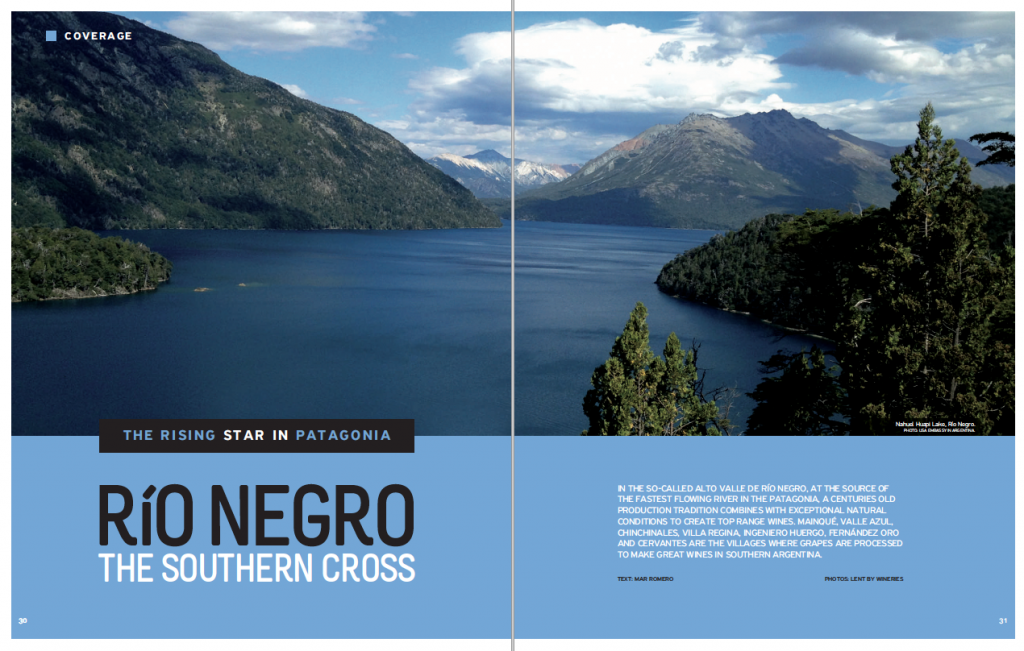
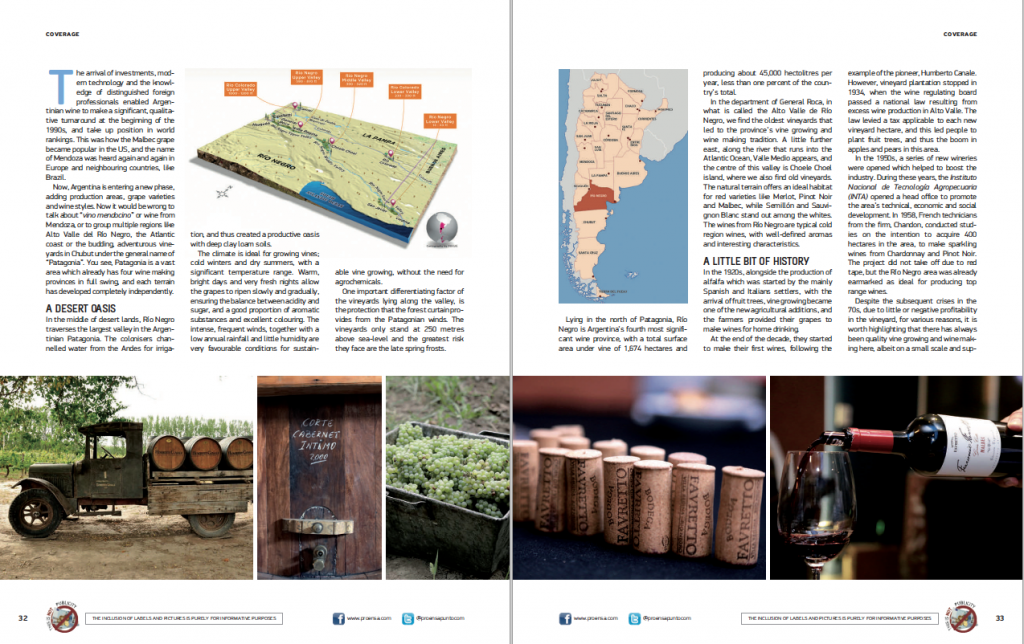
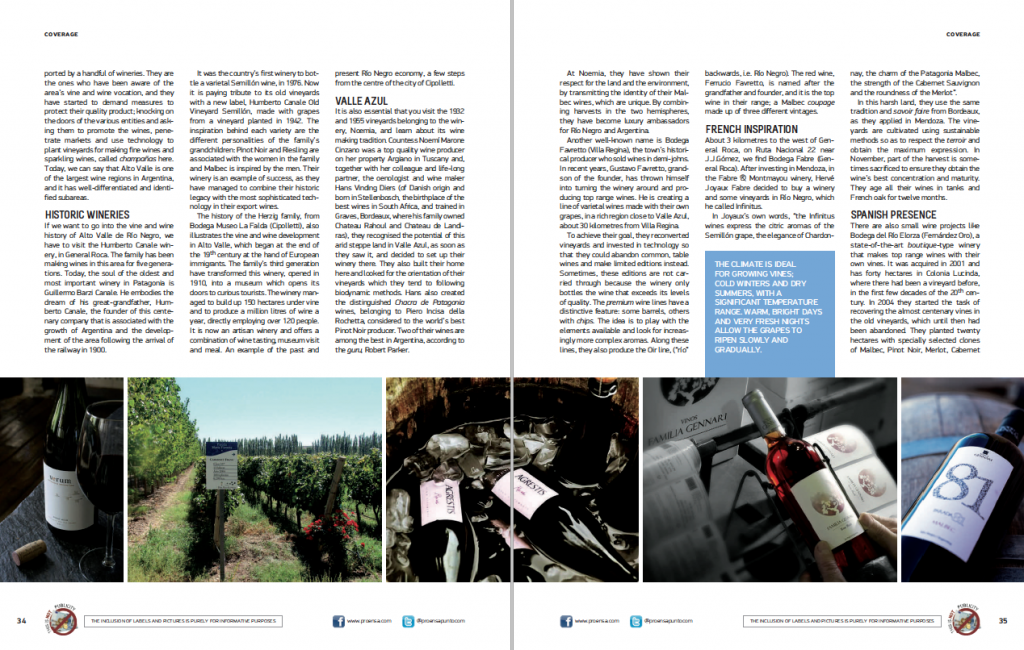
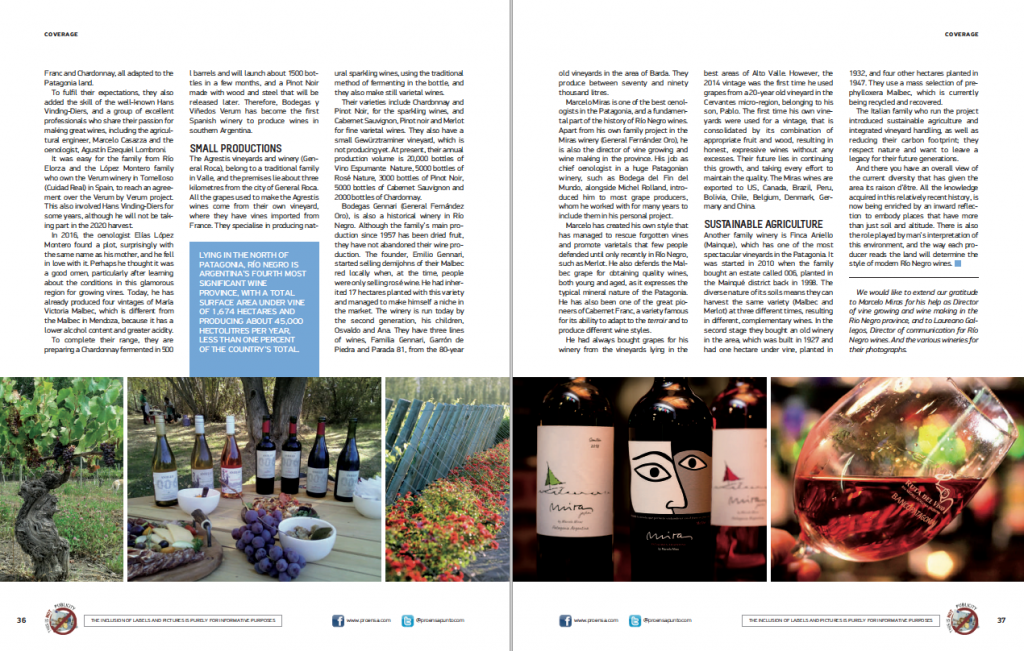

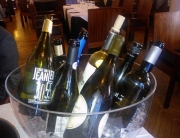
Deje su comentario
Debe estar logged in para comentar.